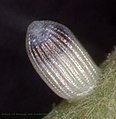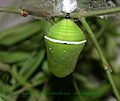Tirumala septentrionis, the dark blue tiger,[1][2] is a danaid butterfly found in the Indian subcontinent and Southeast Asia.[1][2]
| Dark blue tiger | |
|---|---|
 | |
 | |
| Male underside both T. s. dravidarum Kerala, India | |
| Scientific classification | |
| Domain: | Eukaryota |
| Kingdom: | Animalia |
| Phylum: | Arthropoda |
| Class: | Insecta |
| Order: | Lepidoptera |
| Family: | Nymphalidae |
| Genus: | Tirumala |
| Species: | T. septentrionis |
| Binomial name | |
| Tirumala septentrionis (Butler, 1874) | |
Description
This section may need to be rewritten to comply with Wikipedia's quality standards, as this description is mainly just a list of differences between this and T. liminiace; it should be described independently in its own terms. (September 2024) |
Tirumala septentrionis has a wingspan from 80–115 mm.[3][4] The species closely resembles Tirumala limniace, but is sufficiently distinct to be easily recognized, even on the wing. Compared to T. limniace, its upperside is darker and the semihyaline markings are narrower, more distinct, and of a bluer tint. In the forewing, in interspace 1 the two streaks are narrower, never coalescent, and the upper streak forms an oval detached spot; the short streaks above vein 5 are outwardly never truncate, always acute. In the hindwing, the two streaks of the discoidal cell united at base are wide apart at their apices, with the lower streak never formed into a hook. On the underside, this species is generally darker, the apex of the forewing and the whole of the ground colour of the hindwing not being of the conspicuous golden brown that they are in T. limniace.[3][4]
Distribution
The Himalayas from Simla to Sikkim, into Assam, Myanmar, Cambodia and Southeast Asia; Odisha; West Bengal, southern India, the Western Ghats and Nilgiris; Sri Lanka.[1][2]
Habits
This species is one of the most dominant, making up 78% of the population during the migratory season in southern India, where many species undertake migration. Both males and females seem to migrate in equal proportions.[5]
Life cycle
Caterpillar is similar to that of T. limniace (see Journal of the Bombay Natural History Society x, 1896, p. 240). It is said by MacKinnon and de Nicéville to feed on Vallaris dichotoma (Journal of the Bombay Natural History Society xi, 1807, p. 212).[3] Other species include Cosmostigma racemosa,[6] Heterostemma brownii and Cocculus species.[7]
- Egg
- Caterpillar
- Pupa
- Male T. s. septrionis
See also
References
External links
Wikiwand in your browser!
Seamless Wikipedia browsing. On steroids.
Every time you click a link to Wikipedia, Wiktionary or Wikiquote in your browser's search results, it will show the modern Wikiwand interface.
Wikiwand extension is a five stars, simple, with minimum permission required to keep your browsing private, safe and transparent.




